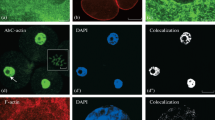Abstract
Actin has been purified from various non-muscle cells and characterized by its molecular weight and ability to polymerize into filaments. Although the occurrence of this protein has been postulated in the mammalian eye lens after observation of actin-like filaments in the electron microscope1,2, definite (bio)chemical proof has been provided only recently3. Amino acid analysis, peptide mapping and affinity chromatography revealed the identity of lens actin with the corresponding protein in other tissues. As the filaments could be obtained by co-isolation with highly purified lens plasma membranes, we were interested to know how the actin-containing structures were located in situ. In the experimental approach reported here, the indirect immunofluorescence technique (IFT)4 was applied to unfixed cryostat sections of lens tissue. The distribution of actin in calf, rat and pigeon lens is described, and evidence from this for the role of actin in visual accommodation discussed.
Similar content being viewed by others
References
Bloemendal, H., Zweers, A., Vermorken, F., Dunia, I. & Benedetti, E. L., Cell Diff. 1, 91–106 (1972).
Benedetti, E. L. et al. Biochim. biophys. Acta 457, 353–384 (1976).
Kibbelaar, M. A., Selten-Versteegen, A. M. E., Bloemendal, H., Dunia, I. & Benedetti, E. L. Eur. J. Biochem. 95, 543–549 (1979).
Feltkamp, T. E. W. & van Rossum, A. L. Clin. exp. Immun. 3, 1–16 (1968).
Lidman, K. et al. Clin. exp. Immun. 24, 266–272 (1976).
Johnson, G. D., Holborrow, E. J. & Glynn, L. E. Lancet ii, 878–879 (1965).
Bloemendal, H. Science 197, 127–138 (1977).
Gullstrand, A. in Handbuch der Physiologischen Optik von v. Helmholtz Vol. 1, 3 (Voss, Hamburg, 1911).
Kleifeld, O. Documenta ophthal. 10, 132–173 (1965).
Kleifeld, O., Fuchs, R., Hockwin, O. & Arens, P. Ber. Versamm. dt. Ophthal. Ges. 58, 220–231 (1953).
Kleifeld, O., Hockwin, O. & Arens, P. Albrecht v. Graefes Archiv Ophthal. 156, 467–479 (1955).
Walls, G. L. The Vertebrate Eye and its Adaptive Radiation (Hafner, New York, 1963).
Mousa, G. Y. & Trevithick, J. R. Expl Eye Res. 29, 71–81 (1979).
Rafferty, N. S. & Goossens, W. Expl Eye Res. 26, 177–190 (1978).
Klethi, J. & Mandel, P. Nature 205, 1114–1115 (1965).
Zapisek, W. F. & Papaconstantinou, J. Biochim. biophys. Acta 277, 231–234 (1972).
Mandel, P. & Klethi, J. Biochim. biophys. Acta 28, 199–200 (1958).
Van Heyningen, R. Scient. Am. 12, 70–81 (1975).
Poels, L. G., Van Niekerk, C. C., Franken, M. A. M. & Van Elven, E. H. Expl Parasit. 42, 182–193 (1977).
Author information
Authors and Affiliations
Rights and permissions
About this article
Cite this article
Kibbelaar, M., Ramaekers, F., Ringens, P. et al. Is actin in eye lens a possible factor in visual accommodation?. Nature 285, 506–508 (1980). https://doi.org/10.1038/285506a0
Received:
Accepted:
Issue Date:
DOI: https://doi.org/10.1038/285506a0
- Springer Nature Limited
This article is cited by
-
Lens cytoskeleton and transparency: A model
Eye (1999)





